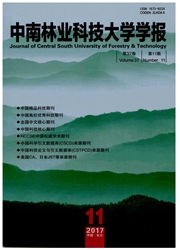

 中文摘要:
中文摘要:
通过SEM、TEM表征了杉木-纳米TiO2复合材料的结构,并基于二元复合理论,结合XRD、EDXA及XPS等分析其复合机理。结果表明:纳米TiO2粒子极易与杉木木材组分中的氧键结合,形成原位复合,其表面存在的不饱和残键和羟基,与杉木组分中的羟基、乙酰基及羧基等形成化学结合;有机相(木材组分)与无机相(纳米TiO2粒子)以共价键或部分共价键紧密联接,可使两相界面完全或部分消失,从而使复合材料性能显著提高。
 英文摘要:
英文摘要:
The structure of the Chinese fir/nano-TiO2 composite is characterized by SEM, TEM etc.. Based on duality composite theory, by using XRD, EDXA and/or other spectroscopy etc., the composite mechanism is analyzed. The results show that nano-TiO2 particles can be easily bonded with the oxygen inside the wood and formed in-situ composite. On the surface of nano-TiO2 particles, there areunsaturated residual bonds and hydroxy, which combined in chemical state with hydroxyl, acetyl and carboxyl etc. inside the wood. The organic phase(wood components) are connected closely to the inorganic phase(nano-Ti02 particles) in the forms of covalent bond or partial covalency, Which will cause the interface of the two phase wholly or partly disappearing, thus obviously promoting theperformance of the composite material.
 同期刊论文项目
同期刊论文项目
 同项目期刊论文
同项目期刊论文
 Optimization of debittering of soybean antioxidant hydrolysates with beta-cyclodextrins using respon
Optimization of debittering of soybean antioxidant hydrolysates with beta-cyclodextrins using respon Feature of air classification product in wheat milling: Physicochemical, rheological properties of f
Feature of air classification product in wheat milling: Physicochemical, rheological properties of f 期刊信息
期刊信息
